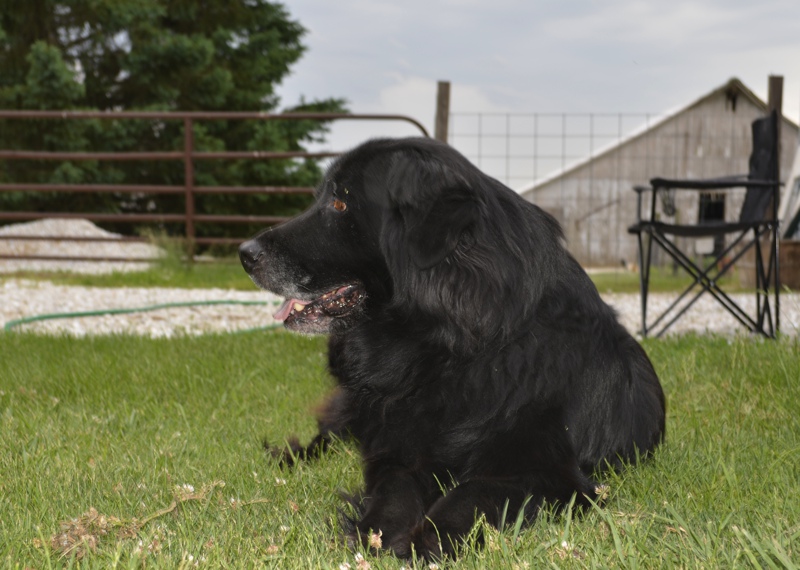Golden Newfie

A handsome and confident dog, the Golden Newfie is a combination of the loving Golden Retriever and the placid Newfoundland. A hybrid dog with a heart of gold, Golden Newfies are gentle giants that have plenty of patience for children. However, given their sheer size they require constant supervision when around the younger members of the family.
Large and heavy dogs with dense fur, the Golden Newfie will be more robustly built than their Golden Retriever parent and can tip the scales at more than 60kg. These dogs are not low maintenance as they need plenty of space and substantial exercise. On top of this, they are known for their impressive shedding and drooling ability!
About & History
The Golden Newfie is thought to have been developed within the United States at the end of the 20th century. Breeding the Golden Retriever and Newfoundland together probably seemed a natural thing to do as they have such similar personalities and both make excellent family pets.
The Golden Retriever
The Golden Retriever is a Scottish breed best-known for its sweet nature and luxurious wavy, golden coat. Originally kept as a working dog, they were developed in the 1800s to hunt and retrieve prey on both land and water. They are the progeny of the Tweed Water Spaniel (a breed that has since gone extinct) and the Flat Coated Retriever.
It is likely that other breeds, such as the Irish Setter, also contributed to their genetics over the years. Their biddable nature and intelligence means that they are employed in a variety of roles, including as guide dogs, sniffer dogs and even therapy dogs. They were recognised by the Kennel Club in their Gundog group in 1913, though were initially known as ‘Yellow Retrievers’.
The Newfoundland
Newfoundland dogs are the indigenous dogs of Newfoundland and were first found there in the 17th century, though were likely present for many hundreds of years prior to this. They were, much like the Golden Retriever, kept as working dogs and they would assist their humans by pulling heavy loads and hauling fishing nets.
Though the majority of individuals are today kept as pets, a small number are used as search and rescue dogs with their strength and dependability making them well-suited for the part. These dogs are excellent swimmers thanks to their water repellant coat and webbed paws, meaning they can also work as ‘lifeguards’, rescuing swimmers in distress.
Appearance

Without a doubt, the most impressive thing about the Golden Newfie is its size. Not only are they tall and heavy, they also have stocky bodies with broad skulls and massive jaws. If they weren’t so loving and soppy, they could potentially look intimidating! Their well-furred ears hang to the side of their wide head and their brown eyes sit well back in their skull. They have a black nose, large jowls and slightly pendulous lips. Their neck is thick and strong, while their chest is notably deep. Their limbs are straight and solidly built, ending in webbed feet, which allow for a superior swimming ability. Their tail is medium in length and is typically heavily furred.
Reaching heights of between 51cm and 68cm and weights ranging from 34kg to 60kg or even more, the Golden Newfie is a formidable beast! Despite their large size, they have managed to retain a good deal of their athleticism and are still able to run and swim remarkably well. The fur of the Golden Newfie is not always golden (despite the name!) and can be brown, red or even black. The fur has a slight wave to it and is particularly dense, allowing for dogs to regulate their heat well in the winter and when in the water.
Character & Temperament
These calm and peaceful dogs rarely get flustered and tend to take things in their stride. They form close bonds with their family members and can be protective of them, though rarely act hostile or aggressive in any way. Some describe them as ‘nanny dogs’, as they are particularly caring when around the younger members of the household.
Though one may assume that the Golden Newfie is lazy, this is far from the truth and they actually like to be in on the action and to tag along on any outdoor adventures. Once sufficiently exercised, they will be happy to chill out on the sofa each night.
The vast majority of Golden Newfies will get along well with other animals, though owners should not assume that this will always be the case and are encouraged to socialise them thoroughly as soon as they are brought home.
Trainability
As both parents were developed to be working dogs, it’s little wonder that the Golden Newfie makes a wonderful pupil. Not only are they quick on the uptake, they also enjoy learning and will relish any opportunity given to them to learn something new. Owners need not have a lot of experience and should be able to train them to a high level.
Golden Newfies can be a little sensitive at times and do not respond well to harsh training methods or punishment. Best results are achieved with patience and positive reinforcement. For most, a few tasty treats can make training sessions even more successful!
Health
Almost inevitably, the larger a dog, the lower their lifespan and the Golden Newfie only tends to live to around 10 years of age. Given their relatively short life, it’s even more important to ensure they enjoy good health and do not suffer from chronic health complaints in their golden years.
Hip Dysplasia
Malformed hips can dramatically affect a dog’s quality of life and will lead to arthritis in later life. Prevention is better than cure so breeders should be sure to only use dogs that have screened negative for this orthopaedic condition. Most of those affected will require daily medication to help control the local pain and inflammation in their hind limbs. Keeping dogs slim can also go a long way towards controlling the associated symptoms.
Subaortic Stenosis
This is a congenital heart defect that causes obstructed blood flow from the heart and can eventually lead to heart failure. Large breed dogs are often the ones that are affected. Mild cases may not require therapy but should be monitored closely.
Cherry Eye
Cherry eye tends to occur in young dogs and, for many, both eyes will eventually be affected. A surgery is recommended to replace the prolapsed gland into the eye. Removing the gland is not advised as this can reduce local tear production and lead to a dry eye going forward.
Bloat
Deep-chested dogs tend to be the ones that get bloat, although why some dogs develop it and others do not is not yet fully understood. Signs are dramatic and tend to come on quickly, over the course of a few hours. If not treated promptly, most dogs will pass away from organ failure and shock.
Obesity
Though obesity is not an inevitability, some dogs are genetically more predisposed than others. As larger dogs tend to struggle more with joint disease, it is especially important for them to maintain a lean body condition and to avoid becoming overweight. A combination of daily exercise and sensible eating is all that is needed to prevent dogs from piling on the pounds.
Exercise and Activity Levels
At least an hour of exercise each day is necessary to keep the Golden Newfie happy and in shape. They love to swim no matter the weather and will instinctively know how to do it. As they have a natural tendency to want to ‘rescue’ swimmers that are shouting or jumping about, get ready for lots of ‘rescue attempts’ if playing with them in the family pool!
Grooming
The thick double coat of the Golden Newfie can quickly become matted if not kept on top of and brushed regularly. All areas need brushing every day, especially the fur under the armpits, groins and on the legs.
As the ears of the Golden Newfie are folded down and they love to get wet, it’s important to keep a close eye out for ear infections. After every bath or swim, their ear canals need to be dried thoroughly. Each day, the ears should be checked for any redness, waxy build-up or discomfort.

